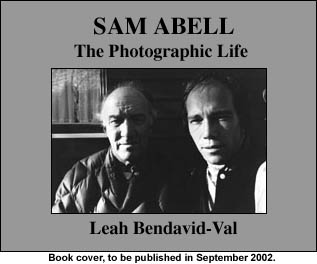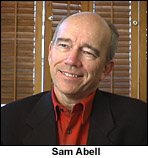
|
Longtime
collaborators and friends Sam Abell and Leah Bendavid-Val are producing
a new book on the life and photography of Abell to be published in
July 2002. Leah interviewed Sam for The Digital Journalist at National
Geographic headquarters in Washington D.C.
 LBV:
The Photographic Life is a major retrospective. How long have
you been working on it? LBV:
The Photographic Life is a major retrospective. How long have
you been working on it?
SA: Directly, eight years. I began work on it even before finishing
our last major book project which was National Geographic: The
Photographs. That book was about honoring the work done by my
colleagues. I felt a debt to National Geographic and paid it with
my work on that book. With its publication the way was cleared for
me to concentrate on my own life's work.
LBV: Can you describe how the book evolved - how it started and how
it evolved into the form it now has?
SA: The first thought was to do a standard essay and portfolio approach
but it became evident that such an approach left out too much. For
example there was the extensive black and white photographic diary
I've kept most of my life. In addition I was interested in showing
the process of photography and the straight gallery approach wasn't
right to show either of those. Finally I wanted a fresh approach because
I love bookmaking as much as photography.
LBV: What is the format as it exists now?
 SA:
The book has five sections. After your (Leah's) critical essay there
is an autobiographical section which presents, for the first time,
photographs from the black and white diary. These are contrasted with
color photographs taken at the same time. Also included are pertinent
documents - telegrams, letters, vintage photographs, etc - that help
tell the story. It's this section of the book that is being featured
first on The Digital Journalist. SA:
The book has five sections. After your (Leah's) critical essay there
is an autobiographical section which presents, for the first time,
photographs from the black and white diary. These are contrasted with
color photographs taken at the same time. Also included are pertinent
documents - telegrams, letters, vintage photographs, etc - that help
tell the story. It's this section of the book that is being featured
first on The Digital Journalist.
The third section, titled "Seeking the Picture," shows a
selection of my photographs in combination with the pictures that
led up to them. Readers will be able to look behind the well-known
photograph and trace the thought that went into making it by studying
the supporting photographs. Text written by me explains how the pictures
were arrived at. "Seeking the Picture" is original, for
me, in that it shows and discusses how work is done. The fourth section,
"The Photography of Places," presents photographic essays
on particular places I have concentrated on, such as Venice, Newfoundland,
the Galapagos and a single cattle station in northern Australia.
The last section, "The Life Behind Things," is a gallery
of photographs edited to show those themes of my work which are not
editorial but which occupied me artistically across my career. That
may sound complicated but any life has layers. The challenge was to
find a design for the book that honored those complex layers and also
gave integrity to the photographs, the objects and the words.
LBV: Describe that design.
SA: The model for the book is A Maritime Album by John Szarkowski
and Richard Benson, which has a clean, classical design: one photograph,
framed, on the right page and an essay about that photograph on the
opposite page. To that basic design we added one additional element
- another photograph, or object, above the essay on the left side
page. Thus the design is triangular - the three elements relate to
each other but each has its own space and strength. It's clean, but
there is a conversation taking place on each spread.
LBV: How are you combining photographs and text in the autobiographical
section so that you tell the full story of your photographic life?
 SA:
First of all you have to face the fact that there aren't photographs
of important parts of your life. Or that the photographs fall short
of explaining important events or relationships. In facing that I
was inspired by the work of Duane Michals who combined symbolic photographs
with autobiographical writing very movingly. But I'm a documentary
photographer so I couldn't invent images. Therefore I used the photographs
I had and wrote in such a way that the idea inside the photograph
is enlarged. In addition I included letters. It's hard for me to produce
a single photograph that describes the rich relationship I had with
my dad, who taught me photography. But I do have a good documentary
portrait of him. Combining my picture and text and the letter he wrote
me in 1969, with his eleven-point plan for graduating from college,
tells the story. SA:
First of all you have to face the fact that there aren't photographs
of important parts of your life. Or that the photographs fall short
of explaining important events or relationships. In facing that I
was inspired by the work of Duane Michals who combined symbolic photographs
with autobiographical writing very movingly. But I'm a documentary
photographer so I couldn't invent images. Therefore I used the photographs
I had and wrote in such a way that the idea inside the photograph
is enlarged. In addition I included letters. It's hard for me to produce
a single photograph that describes the rich relationship I had with
my dad, who taught me photography. But I do have a good documentary
portrait of him. Combining my picture and text and the letter he wrote
me in 1969, with his eleven-point plan for graduating from college,
tells the story.
LBV: It sounds like you believe in writing with your photographs.
SA: It hasn't always been that way. It was important for me to establish
that I could take pictures that stood alone. But the longer I've been
in photography the more I've been drawn to the worth of writing and
photography. Again, Szarkowski and Michals have been the inspiration.
LBV: The title The Photographic Life suggests completion. Do
you feel that about your life as a photographer?
SA: I'm 56. I've been taking pictures since I was ten. Thirty of those
years have been spent at National Geographic. It feels like
a full life but it is far from over. I was a photographer - and a
very happy one - before the Geographic and I will be one after I leave.
The beautiful thing about this book is that it shows that. It's about
a life, not a career.
Enter
Sam Abell's Photo Gallery
| Intro,
"We had a darkroom in our basement..." |
 |
 |
| Learning
photography from his father. |
 |
 |
| Adjusting
from black-and-white to color. |
 |
 |
| "I
kept a photographic diary in black-and-white..." |
 |
 |
| "Photography
was a spiritual expression..." |
 |
 |
| On
the upcoming book, "The Photographic Life" |
 |
 |
"Color
and back-and-white, which is
more interesting? Which is more truthful?" |
 |
 |
Arriving
at the Geographic from college;
working for the legendary Bob Gilka.
|
 |
 |
On
traveling with his wife, Denise:
"She went on almost every assignment..."
|
 |
 |
"I've
been drawn to remote places where
beauty is hard won, and not easily seen." |
 |
 |
| "When
it comes to equipment, I like to travel light." |
 |
 |
| The
biggest surprise in Sam's career. |
 |
 |
"My
goal was to treat those assignments
like they were fellowships..." |
 |
 |
| On
making "quiet" pictures compelling. |
 |
 |
| On
his flat-horizon perspective. |
 |
 |
| Sam's
most meaningful photograph. |
 |
 |
| On
Saying "Stay This Moment" |
 |
 |
| On
what the future holds. |
 |
 |
|



 LBV:
The Photographic Life is a major retrospective. How long have
you been working on it?
LBV:
The Photographic Life is a major retrospective. How long have
you been working on it? SA:
The book has five sections. After your (Leah's) critical essay there
is an autobiographical section which presents, for the first time,
photographs from the black and white diary. These are contrasted with
color photographs taken at the same time. Also included are pertinent
documents - telegrams, letters, vintage photographs, etc - that help
tell the story. It's this section of the book that is being featured
first on The Digital Journalist.
SA:
The book has five sections. After your (Leah's) critical essay there
is an autobiographical section which presents, for the first time,
photographs from the black and white diary. These are contrasted with
color photographs taken at the same time. Also included are pertinent
documents - telegrams, letters, vintage photographs, etc - that help
tell the story. It's this section of the book that is being featured
first on The Digital Journalist. SA:
First of all you have to face the fact that there aren't photographs
of important parts of your life. Or that the photographs fall short
of explaining important events or relationships. In facing that I
was inspired by the work of Duane Michals who combined symbolic photographs
with autobiographical writing very movingly. But I'm a documentary
photographer so I couldn't invent images. Therefore I used the photographs
I had and wrote in such a way that the idea inside the photograph
is enlarged. In addition I included letters. It's hard for me to produce
a single photograph that describes the rich relationship I had with
my dad, who taught me photography. But I do have a good documentary
portrait of him. Combining my picture and text and the letter he wrote
me in 1969, with his eleven-point plan for graduating from college,
tells the story.
SA:
First of all you have to face the fact that there aren't photographs
of important parts of your life. Or that the photographs fall short
of explaining important events or relationships. In facing that I
was inspired by the work of Duane Michals who combined symbolic photographs
with autobiographical writing very movingly. But I'm a documentary
photographer so I couldn't invent images. Therefore I used the photographs
I had and wrote in such a way that the idea inside the photograph
is enlarged. In addition I included letters. It's hard for me to produce
a single photograph that describes the rich relationship I had with
my dad, who taught me photography. But I do have a good documentary
portrait of him. Combining my picture and text and the letter he wrote
me in 1969, with his eleven-point plan for graduating from college,
tells the story. 